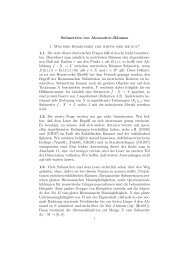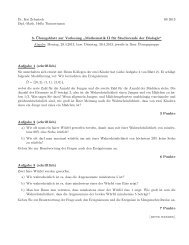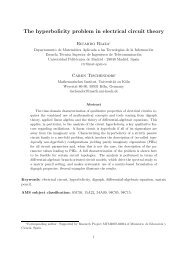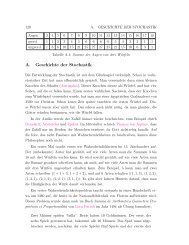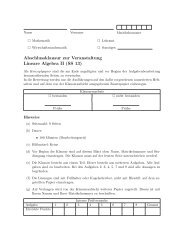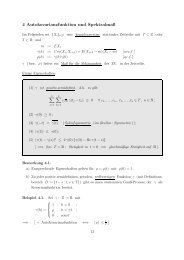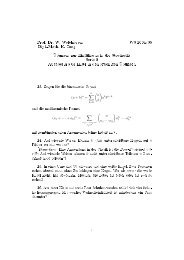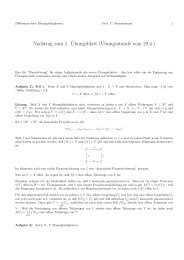Inhaltsverzeichnis - Mathematisches Institut der Universität zu Köln
Inhaltsverzeichnis - Mathematisches Institut der Universität zu Köln
Inhaltsverzeichnis - Mathematisches Institut der Universität zu Köln
You also want an ePaper? Increase the reach of your titles
YUMPU automatically turns print PDFs into web optimized ePapers that Google loves.
DMV Tagung 2011 - <strong>Köln</strong>, 19. - 22. September<br />
Bogdan Matioc<br />
Leibniz <strong>Universität</strong> Hannover<br />
On two-phase flows modelling thin films in porous media<br />
Starting from a moving boundary problem which describes the motion of two fluids in a porous medium,<br />
known as the Muskat problem, we pass to the limit of small layer thickness and obtain a second or<strong>der</strong> degenerate<br />
parabolic system of equations. This strongly coupled system is the generalisation of the Porous<br />
Medium equation to the case of two fluids.<br />
We show that if the initial data are nonnegative, then the degenerate system possesses a global solution<br />
which remains nonnegative and which converges exponentially fast towards some flat equilibrium.<br />
This is a joint work with J. Escher and Ph. Laurencot.<br />
Mark Peletier<br />
Eindhoven University of Technology<br />
Passing to the limit in the Wasserstein Gradient-flow formulation<br />
The Wasserstein gradient-flow structure describes a large number of parabolic, diffusive systems. This<br />
structure has been used to <strong>der</strong>ive many properties of such systems, such as well-posedness, stability,<br />
and large-time behaviour. Here we focus on the use of the gradient-flow structure to prove convergence.<br />
Extending ideas of Stefanelli and Serfaty, we use the Wasserstein gradient-flow structure to prove convergence<br />
in a singularly perturbed diffusion problem. Our test problem arises from the interpretation of<br />
chemical reactions as diffusion in a potential landscape, initiated by Wigner and Kramers in the 1930’s. In<br />
this interpretation a reaction event corresponds to the escape of the diffusing particle from one potential<br />
well into another. In earlier work (with Savare and Veneroni) we proved the convergence of this system<br />
in the limit of high activation energy to the corresponding reaction-diffusion system — but without making<br />
use of the Wasserstein gradient-flow structure.<br />
In this talk I revisit the result, and reprove it using the Wasserstein gradient-flow structure. The method<br />
has some interesting aspects, such as relatively weak compactness requirements, a somewhat surprising<br />
limit, and a tight connection to stochastic particle systems. In addition it has the potential for wide<br />
applicability among the broad class of Wasserstein gradient flows.<br />
This is work with Steffen Arnrich, Alexan<strong>der</strong> Mielke, Giuseppe Savare, and Marco Veneroni.<br />
Wolfgang Reichel<br />
KIT - Karlsruhe <strong>Institut</strong>e of Technology<br />
Symmetry of solutions for quasimonotone second-or<strong>der</strong> elliptic systems in or<strong>der</strong>ed Banach<br />
spaces<br />
We consi<strong>der</strong> symmetry properties of solutions to nonlinear elliptic boundary value problems defined on<br />
bounded symmetric domains of R n . The solutions take values in or<strong>der</strong>ed Banach spaces E, e.g. E = R N<br />
or<strong>der</strong>ed by a suitable cone. The nonlinearity is supposed to be quasimonotone increasing. By consi<strong>der</strong>ing<br />
cones which are different from the standard cone of componentwise nonnegative elements we can prove<br />
symmetry of solutions to nonlinear elliptic systems which are not covered by previous results. We use<br />
methods based on maximum principles (the method of moving planes) suitably adapted to cover the<br />
case of solutions of nonlinear elliptic problems with values in or<strong>der</strong>ed Banach spaces.(With Gerd Herzog,<br />
Karlsruhe.)<br />
195




